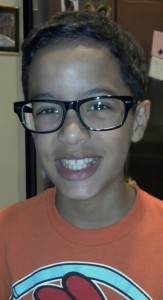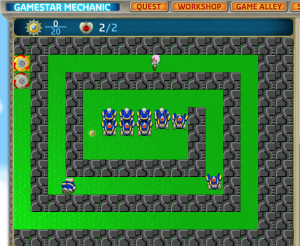 One morning last summer in DeRidder, Louisiana, Angel Acevedo-Martinez’s father came into his room and woke him up with exciting news. Angel’s 6th grade math teacher, Miss Sanchez was on the phone to tell him that his game, The Arcade, had been chosen as a winner in the National STEM Video Game Challenge in Washington, DC. Before that spring, Angel had never designed a game of his own, and now here he was, an award winner in a national competition! Angel’s parents were incredibly proud of him and his little sister was jumping up and down celebrating, but when Angel heard the news, his end of the phone went completely silent.
One morning last summer in DeRidder, Louisiana, Angel Acevedo-Martinez’s father came into his room and woke him up with exciting news. Angel’s 6th grade math teacher, Miss Sanchez was on the phone to tell him that his game, The Arcade, had been chosen as a winner in the National STEM Video Game Challenge in Washington, DC. Before that spring, Angel had never designed a game of his own, and now here he was, an award winner in a national competition! Angel’s parents were incredibly proud of him and his little sister was jumping up and down celebrating, but when Angel heard the news, his end of the phone went completely silent.
Was Angel speechless in shock? Nope – he was still half asleep! “I had to explain to my teacher when school started again that I really was excited!” says Angel, a soon to be 13 year-old night owl who LOVES to stay up late at night (especially in the summer!) and wasn’t expecting an 8am phone call that day.
Angel Acevedo-Martinez started creating video games last year, in his math class for gifted students. His teacher introduced her students to Gamestar Mechanic and the group of about a dozen students had the chance to design their own games during their block class throughout the semester. When asked about getting started making video games, Angel explains, “Well whenever I played games I had always thought these are really cool, I think I’d like to be a game designer!” Over the semester, Angel created The Arcade, a game made up of an impressive number of 20 challenging mini games.
Angel looked to existing games to get his creative juices flowing and brainstorm ideas for all of those mini games. He started playing video games when he was about 7 years-old, and loves playing games like Animal Crossing, classics like Mertroid on Nintendo Land, other games made by kids on Gamestar Mechanic (especially adventure games) and lately, LEGO City Undercover. When playing other designer’s games, Angel values good storytelling and variety – many of the games he enjoys require managing various missions or relationships but he also likes, “a story that I can understand and go along with.” In addition to coming up with ideas for his games on his own, Angel also credits his 10 year-old sister with inspiring a lot of the ideas for mini games in The Arcade. Laughing, he exclaims, “she comes up with crazy ideas!!”
 Angel also had some great playtesters to help him test out his games. Miss Sanchez’s entire gifted math class works on games for the challenge as their Spring event each year, and the students help each other out using “a system where we switched computers and played each others’ games for 5 minutes. Then we would leave comments on a piece of paper saying what we thought.” As the class, and other young designers around the country get ready for the next National STEM Video Game Challenge, Angel has a few pieces of advice:
Angel also had some great playtesters to help him test out his games. Miss Sanchez’s entire gifted math class works on games for the challenge as their Spring event each year, and the students help each other out using “a system where we switched computers and played each others’ games for 5 minutes. Then we would leave comments on a piece of paper saying what we thought.” As the class, and other young designers around the country get ready for the next National STEM Video Game Challenge, Angel has a few pieces of advice:
-
Play lots of other games and look at what you like about them to get ideas but then get creative to make it different and new
-
Get lots of feedback from other players
-
Keep changing your game around to make it fun and challenging
To design a game with the amount of challenge he suggests, “a game is too easy if you get through on first try. But, if it’s too hard, you won’t be able to get through it at all. So you need it to be where you need to get it in a few tries – it can’t be frustrating for the player but at the end they can’t think that it wasn’t enough either.” But ultimately, Angel knows if he’s made a good game when he enjoys playing it and sees other people enjoying themselves too.
So, what will we see next from Angel Acevedo-Martinez? As his 7th grade class goes into 2014, they will begin to look at other programs like Scratch to continue programming games. Although they have not focused on games to teach skills like math as a part of class yet, Angel thinks “that sounds very interesting.” When he’s not designing games in math class, Angel might be found making exploding “elephant toothpaste” in Chemistry (his favorite subject), taking care of his awesome miniature Schnauzer, Bosco, or going out to movies with his friends. Someday he might become a professional game designer, a zookeeper, or because he already has a great signature for it, a doctor!
So for anyone reading this post thinking about whether or not to get involved in game design competitions like the National STEM Video Game Challenge, I’ll leave you with some encouraging words from Angel, one of this year’s inspiring winners:
“… totally do it! It’s fun and it doesn’t even matter if you win or not – you still have something fun that you can play because you did it yourself and you should be really proud.”